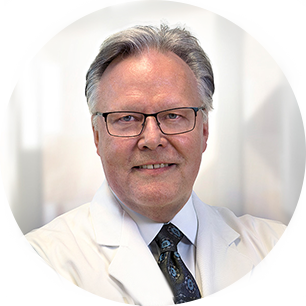
Dr. Steven Sullivan specializes in oral and maxillofacial surgery, orthognathic corrective jaw surgery, and TMJ reconstruction. Dr. Sullivan provides expert care for facial asymmetry, jaw abnormality, condylar resorption, TMJ pain, and arthritis of the jaw. Doctor Sullivan is a native of Colorado and completed his dental training at Baylor College of Dentistry in 1983. He entered private dental practice for one year before starting oral and maxillofacial surgery training at the University of Oklahoma. He completed his residency in 1988 and then undertook additional training at the West of Scotland Plastic and Oral Surgery Unit in Glasgow. Following his training in Scotland, he joined the University of Melbourne and the Royal Children’s Hospital as a surgery fellow in the Plastic and Maxillofacial Surgery Unit.
In 1989, he was appointed to the faculty at the University of Michigan and the following year recruited to Hennipen County Medical Center in Minneapolis, Minnesota to organize the Maxillofacial Trauma Unit within the Department of Dentistry.
Dr. Sullivan returned to the University of Oklahoma in 1992, where he became program director and interim chair of the Department of Oral and Maxillofacial Surgery. Currently, he is Professor and Chairman of the Department of Oral and Maxillofacial Surgery. Dr. Sullivan served on the examination committee for the American Board of Oral and Maxillofacial Surgery and has been president of the Oklahoma Society of Oral and Maxillofacial Surgeons and the Southwest Society of Oral and Maxillofacial Surgeons.
His interests are in corrective jaw surgery and TMJ reconstruction.
He lectures nationally and internationally on these topics.
Exerpts from an interview with NewsOk.com:
(read the full interview here)
by Jaclyn Cosgrove Published: March 3, 2013 12:00 AM CDT
Why get corrective jaw surgery?
Corrective jaw surgery, or orthognathic surgery, is performed to correct bone problems that exist within someone’s jaw that can’t be corrected with only braces on the teeth.
Some people become aware that they need jaw surgery when they go to an orthodontist for braces.
Along with a dental problem, it might be discovered that you have a skeletal problem and need surgery to correct overgrowth or undergrowth of your jaw.
Before the surgery, you likely will have braces on your teeth to move them into a new position. These braces will stay on during your surgery and be adjusted about six weeks after you’ve had jaw surgery.
What happens during the surgery?
Corrective jaw surgery is generally performed in a hospital or surgery center. To begin the surgery, you will be placed under general anesthesia, where you fall asleep and generally won’t feel pain during the procedure.
There’s a misconception that, during jaw surgery, your surgeon will “break your jaw.” Rather, what happens is your surgeon will surgically separate your jaw.
There are various ways to perform the surgery, including segmentalism, in which your surgeon cuts your jaw into segments to move it into place, or through a single-piece method, in which there isn’t as much sectioning of the jaw.
Generally, your surgeon will pull your cheeks back and begin making cuts inside your mouth. Most of the time, incisions are made inside your mouth, but occasionally your surgeon will make an incision in the cheek to correct issues in the lower jaw.
To correct your upper jaw, your surgeon will make cuts high in the upper lip at the base of the nose inside the mouth. Your surgeon will lift the gum tissue and make surgical cuts in the bones of the upper jaw, moving it where it needs to be. Your surgeon will place screws, plates or other devices inside your jaw to ensure it stays in position.
For your lower jaw, your surgeon will make cuts by your wisdom teeth, lift the gum tissue and make a surgical cut. Once this cut is made, your surgeon will be able to move the bottom of your mouth similar to how a dresser drawer moves, sliding it back or forward where it needs to be.



